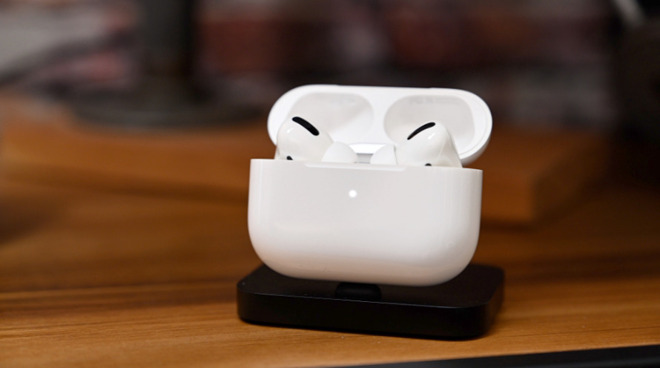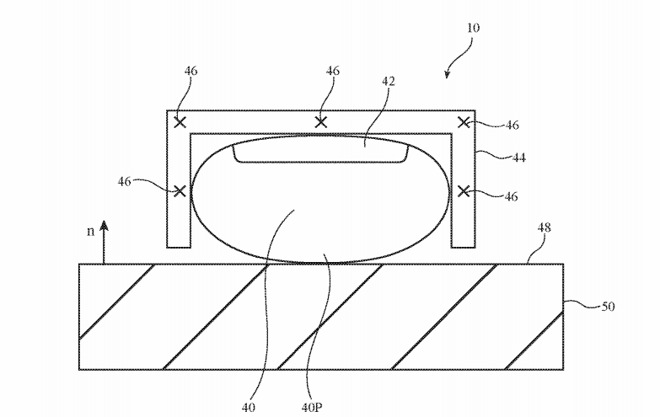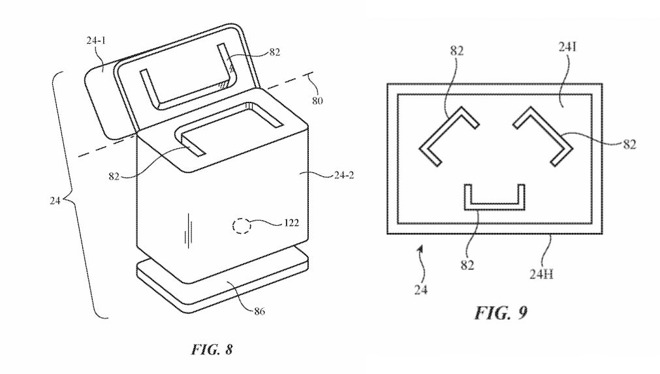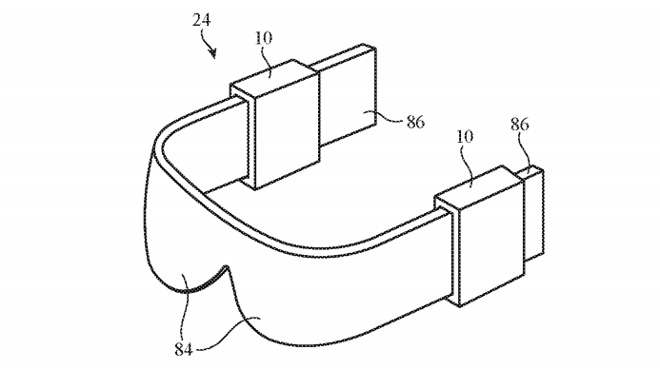Apple's smart rings could recharge in an AirPods-style case
A future control system for Apple devices like Apple Glass could consist of finger-mounted "smart rings" with research suggesting that charging the peripherals could be accomplished with an enclosure similar to the AirPods charging case attached to a VR headset.

An AirPods-style charging case could be used to recharge the finger accessories.
When devising the future of computer-human interactions, companies have many things they have to consider, ranging from the form factor to how each interaction fundamentally works, to the design and the perception of the user to others as they use it. One key area is power, one that is especially useful for wire-free hardware.
While there have been attempts to use smart rings on fingers as a way for a user to control a computer, they have typically taken the form of an actual ring, usually as a fairly large and clunky piece of hardware. Slimming down the size of the ring may make it more appealing to users, but that may also make it harder for manufacturers to include sufficient battery power.
There's also recharging the rings to consider, as users may not see the appeal of connecting their tech jewelry to a cable at the end of the day.
In a patent granted to Apple on Tuesday by the US Patent and Trademark Office titled "Electronic finger devices with charging and storage systems," Apple attempts to solve the power problem by borrowing an idea it used for AirPods.
The patent describes a "finger-mounted device configured to be worn on a finger of a user," which sounds like a smart ring. One which includes a combination of sensors to measure finger movements, which can in turn be interpreted by a host device.

An illustration of the U-shaped device on the back of the finger.
These sensors can include a force sensor to measure force applied by the finger on the housing, some form of haptic output that could be applied to the finger, and systems for receiving power from an external power source. This can include a coil for wireless charging, though the patent specifies this would only be used at a charging point, not when the user is wearing the device.
Though it could be a ring, the patent then goes on to describe it as having a "U-shaped housing," which would slip on the outside edge of the finger rather than the underside. The housing would be "placed over a tip of a finger," presumably close to the finger nail itself, with hinged elements allowing for more freedom of movement around the knuckles.

An AirPods-style charging case, according to the patent
While the patent describes the finger-attached elements in brief, the main thrust of the filing relates to applying power to the accessories. In short, it does so via a separate enclosure for charging.
The patent describes this in two general forms, consisting of an AirPods-style wireless charging case, and in a recess within "head-mountable support structure" on a VR headset or AR glasses.
In each case, the finger devices fit into shaped slots in the housings, orienting them in specific ways to enable them to wirelessly charge using coils. This is very similar to the AirPods charging cases in terms of mechanics, with the differences being the internal elements to accept a different type of device, and whether it's part of a larger headset.
For Apple including such a charging point in a VR or AR headset would be advantageous, as it would mean the headset and the interface devices for the VR or AR system would be kept together, and recharging at the same time.

An Apple headset could have spaces to charge the finger devices.
As well as being able to set the devices to recharge from an outlet, Apple also suggests the use of energy harvesting via a solar cell, and a converter to change kinetic energy into electrical power.
Originally filed in September 2018, the patent lists its inventor as Paul X. Wang.
Apple files numerous patent applications on a weekly basis, but while the existence of a patent indicates areas of interest for Apple's research and development teams, it doesn't guarantee the concepts will appear in a future product or service.
Smart rings have repeatedly appeared in Apple patents in the past, ranging from expanding rings that cover an entire finger, to versions with a touchscreen that are similar to a smartwatch in terms of functionality, to even using the U1 chip to detect where a user is pointing.
The U-shaped device on the back of the finger is reminiscent of another patent from 2019, where Apple suggests contracting the width of a finger-worn device to lightly squeeze a finger. The squeezing would help protrude the finger pad out, giving users a more comfortable sensation when tapping a display or another surface, potentially similar to that of typing on a keyboard.
The squeezing would also feasibly be able to provide some pushback using the method, similar to the resistance of a key on a keyboard during a press, and even general haptic feedback.

An AirPods-style charging case could be used to recharge the finger accessories.
When devising the future of computer-human interactions, companies have many things they have to consider, ranging from the form factor to how each interaction fundamentally works, to the design and the perception of the user to others as they use it. One key area is power, one that is especially useful for wire-free hardware.
While there have been attempts to use smart rings on fingers as a way for a user to control a computer, they have typically taken the form of an actual ring, usually as a fairly large and clunky piece of hardware. Slimming down the size of the ring may make it more appealing to users, but that may also make it harder for manufacturers to include sufficient battery power.
There's also recharging the rings to consider, as users may not see the appeal of connecting their tech jewelry to a cable at the end of the day.
In a patent granted to Apple on Tuesday by the US Patent and Trademark Office titled "Electronic finger devices with charging and storage systems," Apple attempts to solve the power problem by borrowing an idea it used for AirPods.
The patent describes a "finger-mounted device configured to be worn on a finger of a user," which sounds like a smart ring. One which includes a combination of sensors to measure finger movements, which can in turn be interpreted by a host device.

An illustration of the U-shaped device on the back of the finger.
These sensors can include a force sensor to measure force applied by the finger on the housing, some form of haptic output that could be applied to the finger, and systems for receiving power from an external power source. This can include a coil for wireless charging, though the patent specifies this would only be used at a charging point, not when the user is wearing the device.
Though it could be a ring, the patent then goes on to describe it as having a "U-shaped housing," which would slip on the outside edge of the finger rather than the underside. The housing would be "placed over a tip of a finger," presumably close to the finger nail itself, with hinged elements allowing for more freedom of movement around the knuckles.

An AirPods-style charging case, according to the patent
While the patent describes the finger-attached elements in brief, the main thrust of the filing relates to applying power to the accessories. In short, it does so via a separate enclosure for charging.
The patent describes this in two general forms, consisting of an AirPods-style wireless charging case, and in a recess within "head-mountable support structure" on a VR headset or AR glasses.
In each case, the finger devices fit into shaped slots in the housings, orienting them in specific ways to enable them to wirelessly charge using coils. This is very similar to the AirPods charging cases in terms of mechanics, with the differences being the internal elements to accept a different type of device, and whether it's part of a larger headset.
For Apple including such a charging point in a VR or AR headset would be advantageous, as it would mean the headset and the interface devices for the VR or AR system would be kept together, and recharging at the same time.

An Apple headset could have spaces to charge the finger devices.
As well as being able to set the devices to recharge from an outlet, Apple also suggests the use of energy harvesting via a solar cell, and a converter to change kinetic energy into electrical power.
Originally filed in September 2018, the patent lists its inventor as Paul X. Wang.
Apple files numerous patent applications on a weekly basis, but while the existence of a patent indicates areas of interest for Apple's research and development teams, it doesn't guarantee the concepts will appear in a future product or service.
Smart rings have repeatedly appeared in Apple patents in the past, ranging from expanding rings that cover an entire finger, to versions with a touchscreen that are similar to a smartwatch in terms of functionality, to even using the U1 chip to detect where a user is pointing.
The U-shaped device on the back of the finger is reminiscent of another patent from 2019, where Apple suggests contracting the width of a finger-worn device to lightly squeeze a finger. The squeezing would help protrude the finger pad out, giving users a more comfortable sensation when tapping a display or another surface, potentially similar to that of typing on a keyboard.
The squeezing would also feasibly be able to provide some pushback using the method, similar to the resistance of a key on a keyboard during a press, and even general haptic feedback.

Comments